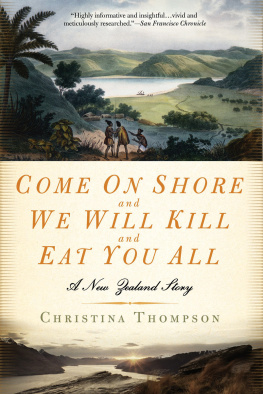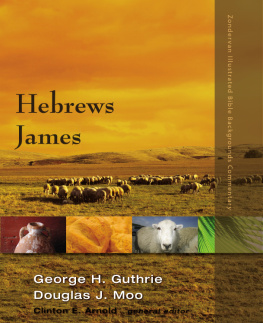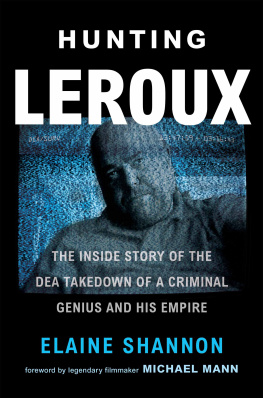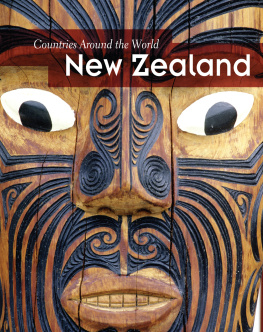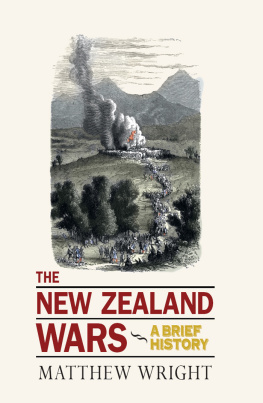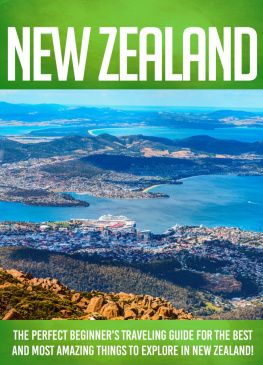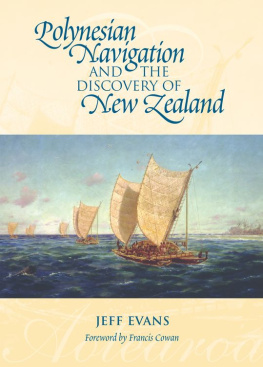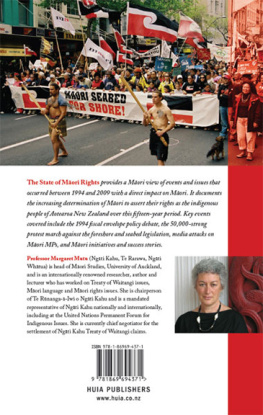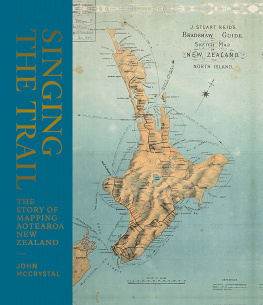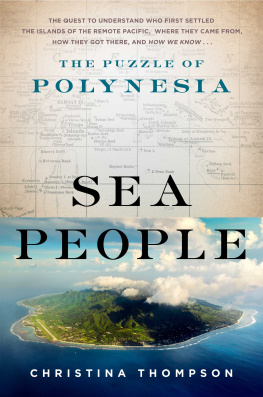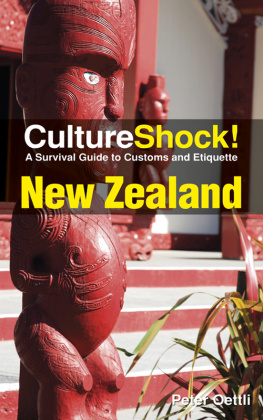COME ON SHORE
AND WE WILL KILL
AND EAT YOU ALL
A New Zealand Story
CHRISTINA THOMPSON
BLOOMSBURY
For Aperahama, Matiu, and Dani Matariki
Time is a flattened landscape, a land of unlinked lakes seen from the air.
Annie Dillard, Living by Fiction
CONTENTS
It is the evening of December 18, 1642, about an hour after sunset, ten, perhaps ten thirty at night, with the sky still holding the last vestige of light on the western horizon. The crews of the two ships Heemskerck and Zeehaen see the light of many fires on shore and four canoes, two of which come toward them through the deepening gloom. It is not their first indication that this island or continentthey know not whichis inhabited, but it is the first time they have been close enough to make out the people.
For five days they have been following the coast, running north with a wide, open sea to their left, rolling in great billows and swells, and a high, mountainous land to their right, masked by low-lying clouds. They have been keeping well out to sea lest the wind, which is predominantly from the southwest, should freshen and drive them onto the shore. They are looking for a landlocked bay or sheltered harbor where they might safely go ashore and see what kind of country this is they have discovered. They want wood and water, fresh food, game, and greens. When they find a long, low sand spit curving round to the east enclosing a large, open bay, they call a meeting of the ships council and make a resolution to land.
The two ships set sail in August from the Dutch outpost of Batavia, now the Indonesian city of Jakarta. They were under the command of Abel Janszoon Tasman, a captain in the service of the Dutch East India Company, and were commissioned to explore what lay south of Java between the Indian Ocean and the coast of the New World. Sailing west and south with the winds to Mauritius, Tasmans ships described a great arc through the Indian and Southern oceans. When they turned east in the high southern latitudes, they passed into a region that was largely unknown. They sailed south of mainland Australia, missing the continent entirely, and made their first landfall on the island now known as Tasmania, which they named Van Diemens Land in honor of the governor-general of the Dutch Indies.
Here they landed long enough to see smoke and signs of fires. They heard people singing and playing a gong somewhere in the forest. They found notches cut into a tree at five-foot intervals and, believing these to be steps, concluded that the people must be giants. But the Tasmanian Aborigines remained hidden in the bush, with watching eyes on our proceedings, or so the nervous Dutchmen believed. There was, in any case, nothing of interest to the Company and so Tasman set sail again to the east. Eight days later they sighted a large land, uplifted high: the first recorded European glimpse of New Zealand.
The evening of December 18 finds them anchored in fifteen fathoms. The wind dies with the setting sun and there follows an hour of glassy calm, broken only by voices and the splash of oars. The Zeehaens boats have been sent to reconnoiter the bay and, when they return with the fading light, they are followed at some distance by two canoes. These come within a stones throw of the Dutch ships and lie there, riding on the swell. Each of the canoes carries a dozen well-made men of average height with skin of a color between brown and yellow and thick black hair tied up in the fashion of the Japanese. Their chests are bare but around their waists they wear some kind of mat or clothing.
After a while, a man in the prow of the larger canoe stands and calls out in a guttural voice words that no one on board the ships can decipher. The masters mate calls back in Dutch and then the man in the canoe lifts something to his lips and blows a blast on what sounds to the sailors like a Moorish trumpet. The second officer of the Zeehaen, who has come out to the Indies as a trumpeter, is sent to fetch his horn and ordered to play a tune. This exchange is repeated a number of times and, when it finally grows too dark to see, the canoes turn and paddle back to shore. Uncertain of the natives intentions, Tasman sets a double watch and sees that the men have muskets, pikes, and cutlasses to hand.
Early the next morning, a canoe carrying thirteen men approaches. The Dutch sailors lean over the rails, showing white linen and knives and trying to indicate by signs that they want to trade. But the natives keep their distance and eventually they leave. Tasman calls a council of his officers and resolves to bring the ships inshore, since, as he notes in his journal, these people (as it seems) are seeking friendship.
But barely has this decision been reached when seven canoes set out from shore, speeding across the water. The Zeehaens skipper, who is on board the Heemskerck, grows nervous about having left his crew unsupervised and sends his quartermaster, Cornells Joppen, back in the cockboat with instructions to the junior officers to be on their guard. The canoes, meanwhile, having reached the ships, take up positions on either side.
Joppen delivers his message and gets back in the cockboat, ordering his rowers to return to the commanders ship. As if on cue, the nearest canoe begins paddling furiously in his direction. Joppen has his back to the canoe and, at first, he does not see it coming. The sailors on board the ships begin to shout, but the natives in the other canoes are also shouting and waving their paddles in the air. The canoe, now flying over the water, rams the cockboat so violently that two of the sailors are tossed into the sea. Joppen reels and grabs for the gunwale but a native jabs him in the neck with a spear and hurls him overboard. The rest of the natives leap from their canoe and fall upon the sailors with clubs, beating them so furiously about the head that three sailors are killed instantly; a fourth lies bleeding in the bottom of the boat.
Joppen and the two sailors manage to swim away and the shallop is sent to rescue them. The natives drown one of the bodies and drag another into their canoe. The Dutch fire heavily with muskets and guns but miss their mark and the natives retreat to shore without suffering any casualties. The Heemskercks skipper is sent to recover the cockboat with its grisly cargo of dead and dying men, and Tasman gives the order to set sail, since no friendship could be made with these people.
The ships weigh anchor and begin to move but the sailors can see a fleet of twenty-two canoes massing like storm clouds in the distance. The canoes, which are much faster and more mobile than the heavy ships, advance with alarming speed, obviously intending to cut off the intruders before they can escape from the confines of the bay. The Dutch wait until the natives are within range and then fire, this time rattling the canoes with shot and hitting a man in the leading canoe who is standing with a little white flag in his hand. The natives abruptly stop paddling. The Dutch spread what canvas they have and the Heemskerck and Zeehaen sail away, leaving behind the Maori armada and the bodies of two of their men.
Tasman calls a meeting of the ships council and then goes below to commit his account of what has happened to paper. Since the detestable deed, he writes, of these inhabitants, committed this morning against four of the Zeehaens crew, teaches us a lesson, we consider the inhabitants of this country as enemies. And to this place he gives the name of Murderers Bay.
I
Paihia
If you stick a hatpin in at Boston and drive it through the center of the earth, you come out very near the Bay of Islands. The first Europeans to go south of the equator expected to find a sort of looking-glass world, backward but recognizable, like people who resembled them but walked on their hands. This, of course, is not how it was, though there were birds that scuttled and animals that flew, trees that lost their bark and kept their leaves, pools of bubbling mud and other wonders. But even today there is something about the antipodes that makes one feel estranged, as if time had stopped or begun reversing, as if under a different heavens one were breathing a different air.
Next page
